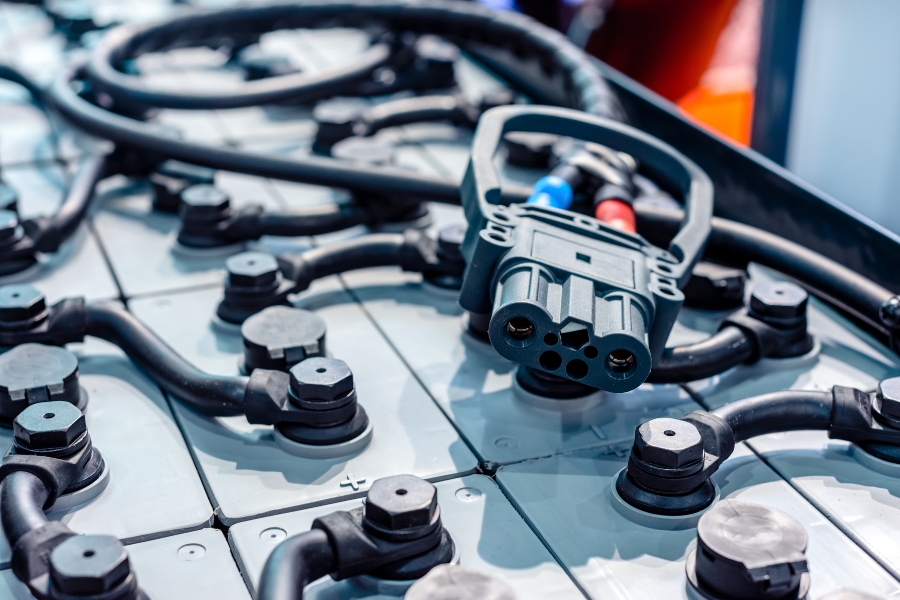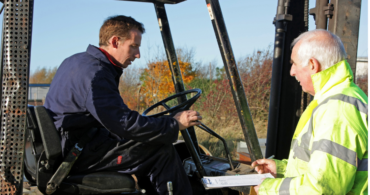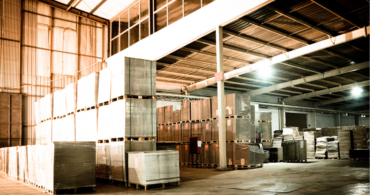Taking care of your forklift batteries and performing routine maintenance gets the best performance from your forklift batteries. Unfortunately, dirty or corroded terminals can shorten the lives of your forklift batteries. Here’s how to spot the symptoms of bad battery terminals so you know when it’s time to replace your forklift batteries.
Forklift batteries are impressively large and heavy devices. This is by design. Not only do these batteries provide power to the entire forklift, ensuring it can lift and place heavy cargo, but the batteries also serve as a counterbalance to the vehicle’s substantial load.
What are forklift battery terminals?
Forklift battery terminals are where the battery connects to the rest of the forklift’s electrical system. Each battery has two terminals: a positive terminal, marked with a plus sign (+), and a negative terminal, marked with a minus sign (-).
When the forklift is on, electrical energy from the battery flows from the positive terminal to the forklift’s motor, hydraulic system and more, enabling the machine to move, raise and lower loads and perform other operations. The electricity then completes the electrical circuit by passing through the battery’s negative terminal. When the battery is plugged into a charger, the process reverses to recharge the battery.
When the terminals are clean, they provide a smooth and efficient transfer of electricity. However, when they are dirty or corroded, it creates resistance in the electrical circuit and can cause many harmful performance problems.
Bad battery terminal symptoms
It doesn’t matter whether the issue is with the positive or negative terminal. Bad positive battery cable symptoms are similar to those of a bad negative battery cable. Also, if you notice some of the following symptoms in your personal automobile, you may have a bad car battery terminal.
Decreased performance
Decreased performance is one of the most common signs of a bad battery terminal. Common indicators include:
- Slow acceleration: one of the first symptoms of bad battery terminals is the forklift noticeably taking longer to reach the desired speed.
- Reduced lifting capacity: the forklift may struggle to lift loads it once could handle easily.
- Shorter runtime between charges: inefficient power transfer may cause the battery to drain faster and increase recharge downtime by reducing the time between charges.
- Inconsistent performance: a bad battery terminal can cause the electrical connection to be intermittent, which can make it difficult for the operator to maintain control.
- Frequent stalling: bad battery terminals can trigger voltage drops or sudden interruptions in the electrical supply, causing the forklift to stall or shut down unexpectedly.
- Dim or flickering lights: bad terminals can affect the lighting system, reducing visibility and increasing the risk of working in poorly lit areas.
- Unusual noises: bad battery terminals can lead to electrical arcing or sparking, which can cause strange noises “under the hood.”
Corrosion buildup
Corrosion is the accumulation of (forgive our use of this technical term) gunk on the battery terminals. Corrosion occurs because chemical reactions inside the battery produce lead sulfate crystals, which gradually accumulate on the terminals. Corrosion acts as an insulating layer between the battery terminals and the electrical cables, making it hard for electricity to flow from the battery.
Corroded battery terminal symptoms include:
- White or greenish powder: usually lead sulfate, but it could be another chemical byproduct resulting from the corrosion process.
- Flaky or crusty deposits: the terminals may appear irregular or rough to the touch.
- Discoloration: the metal may appear dull, darkened or black.
- Buildup around terminal clamps: the above corrosion may also accumulate around the clamps that secure cables to the terminals.
Other corroded battery terminals symptoms include shorter runtimes (because corrosion can cause electricity to leak from the battery), excessive heat generation and flickering lights.
Sulfation
When a battery is undercharged or deprived of a full charge, some hardened lead sulfate (yep, the same stuff that causes corrosion, but this time it) remains inside the battery on the lead plates. Once the buildup of these battery crystals begins, it continues with every use, resulting in what’s known as battery sulfation. While you can’t see this damage without opening the battery, you will notice the effects.
Some everyday performance issues of sulfation include:
- Reduced runtime.
- Being unable to hold a charge.
- Longer charge times: sulfation increases resistance within the battery, making it difficult for the battery to accept and store a charge.
- Difficulty starting.
- Low battery voltage.
- Poor performance in cold weather: winter conditions already reduce a battery’s capacity; when combined with sulfation, the performance is often further compromised.
- Corrosion (because, of course).
- Bulging or swollen battery case: this indicates severe sulfation.
Loose or damaged connections
The forklift’s entire electrical system connects to the battery through two smallish cables that attach to the positive and negative terminals. All it takes is for one or both of those connections to become loose, and it disrupts the electrical current throughout the forklift.
A common cause of a loose connection is everyday wear and tear caused by a forklift’s near-constant movement and vibrations during daily operation. Plus, forklifts often work in environments filled with dust, dirt and moisture. Exposure to these harsh conditions can lead to weakened electrical connections.
Another common cause of loose connections is a bit of an oxymoron: overtightening. Overtightening at the terminal clamps can damage the connections, meaning the cables no longer fit as tightly as they should.
Common bad battery connection symptoms include:
- Unstable power: one of the main loose battery terminal effects is erratic forklift behavior, such as sporadic operation or unexpected shutdowns.
- Battery drainage: loose connections can cause the battery to drain when the forklift is not in use, leading to shorter battery life and increased downtime.
- Heat generation: loose connections create “hot spots” that can damage terminals, cables and other components.
- Voltage drops: current trying to pass through a loose connection can result in insufficient power reaching the forklift’s electrical components.
Spilled Acid
A bad battery terminal can cause acid to collect on the battery’s exterior. Corrosion or loose connections could create gaps between the terminals and the cables. This can result in acid leaking, especially when the forklift operates and the battery vibrates and moves. Damaged terminals, perhaps due to overtightening, can also cause acid leaks. Finally, If the terminal clamps are not secure, they may allow acid to leak from the terminals.
Battery acid is a highly corrosive and toxic substance that can cause severe injuries and damage if not handled correctly. Dealing with a forklift battery that has spilled acid is a hazardous situation that requires immediate attention and proper safety precautions. If you are not adequately trained or equipped to handle the cleanup and disposal, contact a professional hazardous materials team. Safety should always be the top priority when dealing with hazardous substances.
Excessive heat generation
Overheating terminals pose several safety concerns, most crucially the risk of fire. Excessive heat can cause battery acid to vaporize, which is the release of flammable gases. If this gas builds up in the battery compartment, it can result in a fire or worse, an explosion. There are many reasons for excessive heat generation, including:
- High electrical resistance: a bad battery terminal often causes energy loss in the form of heat.
- Overcharging: the battery releases more energy than it can handle, leading to a buildup of heat within the battery and its terminals.
- High current draw: excessively heavy loads or extended usage can cause a forklift to draw a higher current from the battery, resulting in increased heat at the terminals.
- Internal battery problems: damaged cells or a faulty internal connection can cause the terminals to overheat.
Prolonged overheating can make the battery terminals and other components melt, damaging the electrical system. It can also reduce the battery life and jeopardize the forklift operator’s safety.
Difficulty starting
Since these symptoms of bad battery terminals impact the electrical system, one significant function of the forklift often fails: starting. Instead, a clicking sound may be heard, indicating that an inadequate electrical current is reaching the starter motor.
Naturally, a forklift that won’t start significantly affects overall warehouse productivity. The machine is unable to accomplish its necessary tasks, and the operator and other personnel are diverted to troubleshoot and try to repair the situation.
Preventing a bad battery terminal
One of the best ways to avoid the symptoms of bad battery terminals is to stay ahead of the situation with routine maintenance. Establish an inspection schedule to check for corrosion, loose connections and other issues that may cause significant problems. The forklift operator should oversee a visual inspection of the battery terminals before each shift and conduct a detailed review at least once a week or as the manufacturer recommends. If you are unsure about any aspect of inspecting, cleaning or repairing the forklift battery terminals, establish a forklift preventive maintenance program to ensure that your batteries operate at the highest potential
As part of a routine maintenance schedule, be sure that the battery terminals are clean and free of debris. If you notice any corrosion beginning to build up, clean and neutralize the affected areas. Be sure to wear appropriate personal protective equipment (PPE), such as acid-resistant gloves and safety goggles, and keep a fire extinguisher nearby in case of an emergency. Always avoid direct contact with battery acid. If any battery acid contacts your skin, immediately wash the affected area with water and seek medical attention.
You can use a mixture of baking soda and water (the ratio is typically one tablespoon of baking soda per cup of water) to neutralize and remove the acid residue (there are also commercial battery terminal cleaners available). Scrub the battery with a nylon terminal cleaning brush to remove corrosion thoroughly.
Once the terminals are clean, be sure they are completely dry before reconnecting the cables. Make sure that the battery terminals are secure and tight. However, avoid overtightening because that can damage the terminals and lead to more problems.
Always work in a well-ventilated area to ensure that any fumes generated during cleaning can disperse safely. Do not allow the baking soda solution (or professional cleaning product) to enter the battery cells. It can dilute the battery’s chemicals and negatively affect its performance.
If you notice terminals that are cracked, damaged or corroded beyond repair, they must be replaced. Also, if there is extensive damage, severe corrosion or recurring terminal issues despite regular maintenance, it may indicate a significant electrical problem that requires professional diagnosis and repair.
If you plan on maintaining and repairing your forklift batteries, be sure that your staff understands how to maintain good battery terminal connections. It is the employer’s responsibility to ensure that their staff is trained on proper battery handling, inspection procedures and safety protocols.
You can also keep your battery terminals (and the overall battery) clean and operating at peak efficiency by following proper charging practices. Avoid undercharging or overcharging the battery, which can lead to excessive heat generation and terminal corrosion buildup. Consider using terminal protectors or terminal caps. These devices shield the battery terminals from moisture, dirt and other contaminants that can cause damage.
Finally, you should always use high-quality forklift batteries (and terminals). High-quality batteries are proven to withstand the demanding conditions of everyday forklift operations and are less likely to develop issues that require frequent maintenance and replacement.
Remember, these causes and symptoms of bad battery terminals can also be applied to your personal automobile. So, if you’re asking, “Can a loose battery terminal cause a car to stall?” the answer to that question and many more can be found in this article.
Using a forklift with a bad battery terminal can cause damage to the electrical system and other components. This can lead to repeated maintenance and high repair costs. Fortunately, Texas Motive Solutions offers a complimentary forklift fleet performance analysis. We’ll let you know if you need a forklift battery repair and ensure that your fleet is running at peak efficiency. We also offer an extensive range of high-quality forklift batteries to meet your replacement requirements. Give us a call at (888) 316-2459, or you can fill out this form to learn about our services and discover everything we can do for you.


